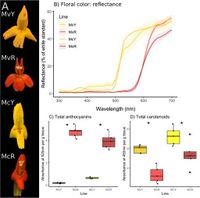The study investigates how floral adaptations in monkeyflowers, particularly the shifts from red to yellow flowers, influence pollinator interactions and may encourage reproductive isolation and speciation. Clear distinctions are drawn between genetic changes and their effects on pollinator preferences. By utilizing multiple levels of biological study, including genetic and behavioral analyses, the research reveals the pathways through which flowers can evolve to better attract different pollinator species.
Key findings indicate that changes in both large-effect mutations and smaller adaptations contribute to the success of yellow morphs, enhancing their attractiveness to bumblebees. This discovery has implications for understanding evolutionary processes related to plant-pollinator interactions and speciation.
In exploring the intersection of floral evolution and pollinator dynamics, researchers turned their attention to two species of monkeyflowers: Mimulus cardinalis and Mimulus verbenaceus. These plants are significant for their transitions between red and yellow flowers, showcasing adaptive walks with potential implications for reproductive isolation and speciation.
According to the authors of the article, "Floral evolution can confer rapid reproductive isolation, often converging in association with pollinator guilds." This statement highlights the key idea that floral characteristics can shift, influencing the relationship between plants and the pollinators that visit them.
The primary focus of the research is on how such shifts contribute to the process of adaptation and reproduction among these flowering plants. The study utilizes comparative analyses, examining traits such as flower color, scent, and physical structures to determine how floral adaptations impact bee behavior.
The research involved multiple methods. Researchers compared the yellow-flowered variants of both M. cardinalis and M. verbenaceus to their red counterparts. Through biochemical analyses and behavioral experiments, they assessed the traits that influence pollinator preferences.
As the authors noted, "By examining intraspecific, incipient pollinator shifts in two related species, we elucidate adaptive walks at early stages." This approach showcases how these adaptations are not simply a matter of color change but involve a suite of interconnected traits that bees respond to when foraging.
The findings suggest fascinating implications for evolutionary biology. The results show that both yellow forms increase volatile emissions from their flowers and exhibit wider tuber openings to facilitate easier access for bumblebee pollinators. These changes suggest a strong correlation between floral traits and the attraction of specific pollinators, potentially altering the reproductive dynamics of these plant species.
In summarizing the findings, the results indicate that shifts in floral colors and accompanying traits promote attraction to bumblebees, thereby affecting reproductive success and isolation. The research shows that these transitions occur independently, suggesting convergent evolutionary pathways.
This understanding has profound implications. As the researchers concluded, "Both yellow forms increased overall floral volatile emissions and had wider, less restrictive corolla openings and greater herkogamy." As new adaptations appear that enhance attraction to different pollinators, the mechanisms of speciation become critical to understanding biodiversity.
These adaptations illustrate how complex phenotypes evolve across generations, providing insight into the ecological role of pollinators in shaping floral diversity. The clear preference observed for yellow flowers among bumblebees reinforces the significance of behavior in plant-pollinator dynamics.
As research in this area continues to progress, future studies may provide deeper insights into how such adaptations occur, the evolutionary pressures acting on these flowers, and the role of environmental factors influencing such evolutionary changes.
Ultimately, the work sheds light on the remarkable adaptability of flowering plants and the intricate relationships they share with their pollinators, illuminating paths toward speciation and biodiversity.




